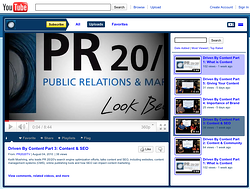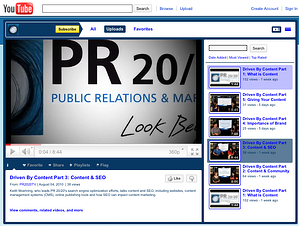As we covered in Part 1 (How to Optimize Video), if your main objectives with video are to maximize reach, build awareness and grow thought leadership, posting it to YouTube is a wise choice. In May 2010, YouTube exceeded two billion video views per day.
 While certainly not the only video-hosting option, YouTube is without question the online video leader. As of March 2010, YouTube had a 40% marketshare, with Hulu in a distant second. For this reason, we focused our optimization recommendations on YouTube.
While certainly not the only video-hosting option, YouTube is without question the online video leader. As of March 2010, YouTube had a 40% marketshare, with Hulu in a distant second. For this reason, we focused our optimization recommendations on YouTube.
YouTube, and other video-host sites like Vimeo, Metacafe and Squidoo, are extremely powerful from a search-engine perspective, so a video posted to these sites has a better chance of ranking higher and quicker on search engines than if it was only posted on your site.
YouTube Ranking Factors
There are a number of ranking factors YouTube uses to prioritize its videos. Some of these factors you can control, while others rely heavily on community engagement:
What You Control
- Title
- Description
- Tags
- Age of video
What the Community Controls
- Views
- Ratings
- Playlist additions
- Flagging
- Embeds
- Shares
- Comments
- Channel views
- Subscribers
- Inbound links
The 11th slide of this SlideShare presentation from Mark Robertson, founder of www.ReelSEO.com, discusses other possible ranking factors.
Optimizing Your YouTube Video
Make sure to take full advantage of every feature YouTube offers as a way to tell the site, and search engines, what your video is about, while also making it easy for viewers to interact with and share.
Profile/Channel
Completely fill out your company’s profile on YouTube before adding any videos. Your profile is also your channel, where people can learn more about you and/or your company. Here you can add:
- Channel name (your name/company name)
- Description of the main topic areas your videos will cover
- Website URL
- Location
- Occupation
- Company
- Schools
- Interests
- And other background information
For an example, visit PR 20/20’s YouTube Channel.
Video Title
Create a video title that includes your main keywords for the topic and is attention grabbing. In many cases, the headline is all potential viewers will see, so it needs to stand out while explaining what the video is about.
Description
Be as informative as possible, but make sure that your most important information and keywords go upfront. On YouTube’s search results page, viewers will only see the first 25 words or so. When relevant, include a link to your website (either your homepage or specific landing page) so viewers can easily click through for more information.
Tags
Unlike the main search engines, YouTube still uses tags to better identify what your video is about. Be sure to tag it with priority keywords and brand-related terms to help viewers find more videos you’ve done. Keep to between five and 10 tags per video. For tags of more than one word, place quotes around them to signify that it is a phrase. (YouTube automatically removes commas.)
Category
Select an appropriate category. There are only a handful to choose from, such as: education, comedy, news & politics or people & blogs.
Thumbnails
Every YouTube video includes a thumbnail image of a still from your video. To optimize your video from a user perspective, you’ll want to make sure the thumbnail is eye-catching and drives views. YouTube gives you three options to choose from, which can be selected during the uploading process, and changed at any time.
Comments
Make sure to allow comments. While not that valuable from a search engine perspective, they are necessary for community engagement. That being said, some brand strategists advise against allowing comments on YouTube because they tend to be more negative than other sites. Our recommendation is allow them to start, moderate, and if they become a problem, remove the option on YouTube but make comments available on your site.
Closed Captioning
Search engines can index closed captioning if you turn it on. The following is a very useful article on getting started with closed captioning on YouTube. YouTube uses Google’s voice recognition software to create a complete transcript, which then scrolls across the bottom of the video. This feature can be turned off by the viewer.
Google voice recognition is not perfect, so to improve the accuracy of your closed captions, you can also submit a “caption file” to YouTube.
Additional Settings
To maximize reach, make sure to change your video’s settings to allow all of the following:
- Public (anyone can search for and view your video)
- Comment voting
- Video responses
- Ratings
- Embedding (gives others the ability to quickly add your video on their site)
- Syndication (so that your video can be seen on mobile devices and, in some cases, TV)
In the next part of this video optimization blog series, we will cover how to optimize video on your website.
Optimizing Video Series
Part 1: How to Optimize Video
Part 3: Optimizing Video on Your Website
Keith Moehring is business development manager and a consultant at PR 20/20, a Cleveland-based inbound marketing agency and PR firm. Follow Keith on Twitter @keithmoehring.

%20Logo_BlueOrange_Trademark.png?width=800&height=269&name=Ready%20North%20(RN)%20Logo_BlueOrange_Trademark.png)




.jpg?width=300&name=Services%20Hub%203%20(3).jpg)


COMMENTS